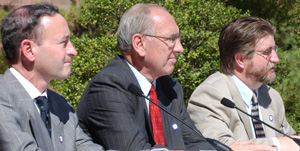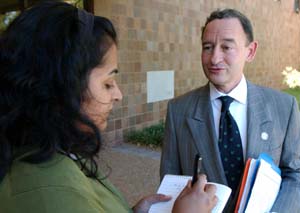The Washington University Athletic Complex looks less and less like the home to some of the most successful NCAA Division III teams every day.
In the first of a series of media briefings, university administrators updated members of the media about the progress of transforming the Athletic Complex into a “town hall” for the second presidential debate, on Oct. 8.

While sounds of electric saws and screwdrivers filled the inside of the Athletic Complex, Ralph Thaman, associate vice chancellor and director of facilities, planning and management, said the university is well on the way to being ready.
“The main field house is the place where the debate will be held, but all through this building are rooms, offices, hallways that we have to turn into a campaign work space, offices that are usually used by our coaches and other members of our athletic department have to be turned over to the Commission (on Presidential Debates) and the campaigns,” Thaman said.
“We will be ready when it’s time to turn the switch and have the debate. The facility will be ready.”
Washington University Chancellor Mark S. Wrighton opened the media briefing with welcoming remarks and emphasized that many people have come together to make the debate preparations run smoothly.
“It’s rewarding to have the opportunity again to host a presidential debate,” Wrighton said. “From what we learned last week (at the University of Miami), we’ll probably have upward of 60 million people watching the debate, and this provides a special opporuntiy for all Americans to better understand the issues that we face.
“And this represents a very special opportunity for our students, our faculty and our alumni. There are a great many of our staff that are working hard on behalf of the candidates and on behalf of the Commission on Presidential Debates.”

Steve Givens, chair of Washington University’s Debate Steering Committee and assistant to the chancellor, updated reporters on arrangements being made to accommodate the public viewing area. They will have a stage and sound system set up on the university’s nearby intramural fields, south of the Athletic Complex across Forsyth Boulevard.
John Schael, director of athletics, outlined some of the differences from the first debate hosted by Washington University, in 1992, and the Oct. 8 debate.
“In 1992, there were four networks,” Schael said. “In 2004, we have six. In 1992, three candidates. In 2004, two candidates in a town-hall format.
“And in 1992, and this is hard to believe, there was no Internet. Only phones, faxes and scanners. In 1992 we created darkrooms, we took our showers, brought in washing tubs so photographers could wash their negatives. And today we enjoy the miracle of digitalization. But there’s one common thread that ties 1992 to 2004, and that’s simply this: And extraordinary team working together to bring about spectacular results as we prepare for the 2004 debate.”
George Lueders, project manager for SBC Communications Inc., added that there are 1,500 phone lines, most equipped with high-speed DSL data access, and that more than 300 SBC employees — many of whom worked on the first debate — have spent the better part of a year working on the project.
The members of the media were then given a tour of the facilities by Schael to see the ongoing construction work in the debate hall and in the media filing center where “spin alley” will be set up after the debate.